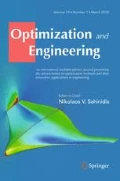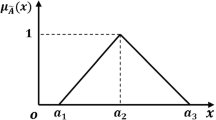Abstract
In this paper, we present a new approach to solve multi-attribute decision making (MADM) problems considering subjective preferences and non-preferences of the decision maker in the form of triangular fuzzy preference relations and triangular fuzzy non-preference relations, respectively. Some important characteristics of these relations are used to form non-linear programming problems corresponding to lower, middle, and upper limits of the triangular fuzzy numbers. The optimization problems corresponding to lower and upper limits are solved to obtain corresponding limits of basic triangular fuzzy multiplicative preference weights (TFMPWs) and basic triangular fuzzy multiplicative non-preference weights (TFMNPWs). The obtained optimal weight values are used to find the modal values of TFMPWs and TFMNPWs that helps in the ranking of the alternatives. The working of the proposed approach is demonstrated by solving a MADM problem from the literature. Furthermore, to validate the superiority of the proposed approach, a comparative analysis with similar existing approaches has been provided. The obtained results reveal the applicability and usefulness of the proposed approach.



Similar content being viewed by others
References
Atanassov KT (1999) Intuitionistic fuzzy sets. In: Intuitionistic fuzzy sets. Physica, Heidelberg, pp 1–137
Bridgman PW (1922) Dimensional analysis. Yale University Press, New Haven
Chang PT, Lee ES (1995) The estimation of normalized fuzzy weights. Comput Math Appl 29(5):21–42
Chen SJ, Hwang CL (1992) Fuzzy multiple attribute decision making: methods and applications. In: Lecture notes in economics and mathematical systems. Springer, Berlin, p 375
Chiclana F, Herrera-Viedma E, Alonso S, Herrera F (2009) Cardinal consistency of reciprocal preference relations: a characterization of multiplicative transitivity. IEEE Trans Fuzzy Syst 17(1):14–23
Deli I (2020) A TOPSIS method by using generalized trapezoidal hesitant fuzzy numbers and application to a robot selection problem. J Intell Fuzzy Syst 38(1):779–793
Deli I, Karaaslan F (2020) Bipolar FPSS-tsheory with applications in decision making. Afr Mat 31:493–505
Deli I, Şubaş Y (2017) Some weighted geometric operators with SVTrN-numbers and their application to multi-criteria decision-making problems. J Intell Fuzzy Syst 32(1):291–301
Dubois DJ, Prade H (1980) Fuzzy sets and systems: theory and applications. Academic Press, New York, p 144
Fedrizzi M, Krej J (2015) A note on the paper fuzzy analytic hierarchy process: fallacy of the popular methods. Int J Uncertain Fuzz And Knowl Based Syst 23(06):965–970
Gong ZW, Li LS, Zhou FX, Yao TX (2009) Goal programming approaches to obtain the priority vectors from the intuitionistic fuzzy preference relations. Comput Ind Eng 57(4):187–1193
Gong ZW, Li LS, Forrest J, Zhao Y (2011) The optimal priority models of the intuitionistic fuzzy preference relation and their application in selecting industries with higher meteorological sensitivity. Expert Syst Appl 38(4):4394–4402
Gupta P, Mehlawat MK, Grover N (2016) Intuitionistic fuzzy multi-attribute group decision-making with an application to plant location selection based on a new extended VIKOR method. Inf Sci 370:184–203
Gupta P, Mehlawat MK, Grover N, Pedrycz W (2018) Multi-attribute group decision making based on extended TOPSIS method under interval-valued intuitionistic fuzzy environment. Appl Soft Comput 69:554–567
Krej J (2017) On multiplicative consistency of interval and fuzzy reciprocal preference relations. Comput Ind Eng 111:67–78
Liu F, Zhang WG, Zhang LH (2014) Consistency analysis of triangular fuzzy reciprocal preference relations. Eur J Oper Res 235(3):718–726
Liu F, Pedrycz W, Wang ZX, Zhang WG (2017) An axiomatic approach to approximation-consistency of triangular fuzzy reciprocal preference relations. Fuzzy Sets Syst 322:1–18
Ma J, Fan ZP, Jiang YP, Mao JY, Ma L (2006) A method for repairing the inconsistency of fuzzy preference relations. Fuzzy Sets Syst 157(1):20–33
Meng F, Chen X (2017) A new method for triangular fuzzy compare wise judgment matrix process based on consistency analysis. Int J Fuzzy Syst 19(1):27–46
Nagoorgani A, Ponnalagu K (2012) A new approach on solving intuitionistic fuzzy linear programming problem. Appl Math Sci 6(70):3467–3474
Saaty TL (1977) A scaling method for priorities in hierarchical structures. J Math Psychol 15(3):234–281
Saaty TL (1994) Fundamentals of decision making and priority theory with the AHP. RWS Publications, Pittsburgh
Saaty TL (2008) Decision making with the analytic hierarchy process. Int J Serv Sci 1(1):83–98
Tang J, Meng F (2017) A consistency-based method to decision making with triangular fuzzy multiplicative preference relations. Int J Fuzzy Syst 9(5):1317–1332
Uluçay V, Deli I, Ahin M (2018) Trapezoidal fuzzy multi-number and its application to multi-criteria decision-making problems. Neural Comput Appl 30(5):1469–1478
Wang ZJ (2015) Consistency analysis and priority derivation of triangular fuzzy preference relations based on modal value and geometric mean. Inf Sci 314:169–183
Wang ZJ (2018) A goal programming based heuristic approach to deriving fuzzy weights in analytic form from triangular fuzzy preference relations. IEEE Trans Fuzzy Syst 27(2):234–248
Wang YM, Elhag TM (2006) On the normalization of interval and fuzzy weights. Fuzzy Sets Syst 157(18):2456–2471
Xia M, Xu Z, Liao H (2013) Preference relations based on intuitionistic multiplicative information. IEEE Trans Fuzzy Syst 21(1):113–133
Xu Z (2013) Priority weight intervals derived from intuitionistic multiplicative preference relations. IEEE Trans Fuzzy Syst 21(4):642–654
Yoon K, Hwang CL (1981) Multiple attribute decision making methods and applications. Springer, Berlin
Zhu B, Xu Z (2014) Consistency measures for hesitant fuzzy linguistic preference relations. IEEE Trans Fuzzy Syst 22(1):35–45
Acknowledgements
The authors are gratitude to Editor-in-Chief, Guest Editors, and all the reviewers for their valuable comments. Author Faizan Ahemad is supported by DST INSPIRE Fellowship (DST/INSPIRE Fellowship/IF180317). The first author acknowledges the support through MATRICS Scheme of DST-SERB, New Delhi, India.
Author information
Authors and Affiliations
Corresponding author
Additional information
Publisher's Note
Springer Nature remains neutral with regard to jurisdictional claims in published maps and institutional affiliations.
Rights and permissions
About this article
Cite this article
Mehlawat, M.K., Gupta, P. & Ahemad, F. A nonlinear programming approach to solve MADM problem with triangular fuzzy preference and non-preference information. Optim Eng 22, 1091–1116 (2021). https://doi.org/10.1007/s11081-020-09524-9
Received:
Revised:
Accepted:
Published:
Issue Date:
DOI: https://doi.org/10.1007/s11081-020-09524-9




